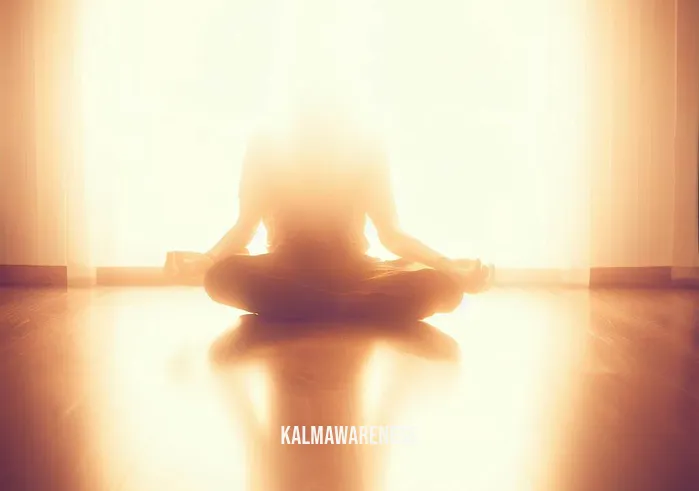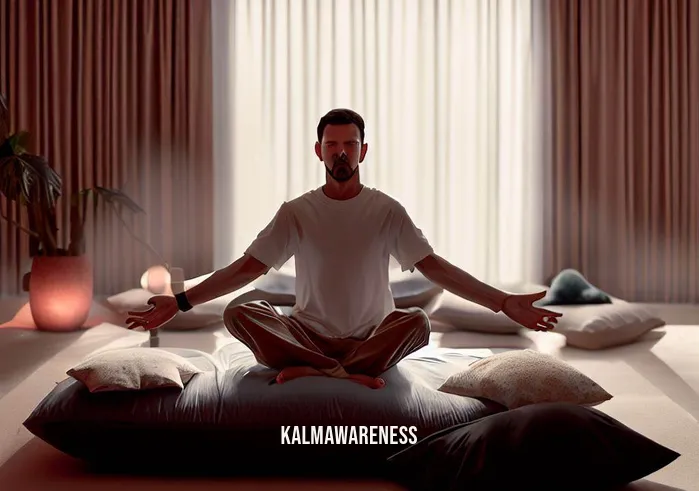Can You Meditate Lying Down on Bed? Demystifying the Posture of Peace
Meditation is an ancient practice rooted in mindfulness and presence, often associated with sitting upright on a cushion or chair. Yet, the question arises, can you meditate lying down on bed? The answer to this query holds significant implications for those who wish to incorporate meditation into their daily lives, especially those who are constrained by physical limitations or are simply more comfortable in a reclined posture. This first segment of our comprehensive essay delves into the nuances and feasibility of lying down while meditating.
The Stigma Around Reclining Meditation
Meditation purists may argue that sitting upright is an essential component for proper technique and alignment, but it’s essential to keep in mind that meditation is an evolving practice that adapts to contemporary needs. While the classical postures have their place and benefits, a rigid stance on this could deter potential meditators from the practice altogether. The ultimate goal is to find a method that helps you attain a peaceful state of mind in which thoughts are not occupied by worry.
The Benefits of Lying Down to Meditate
For those who are considering this lying-down approach, there are several compelling reasons to give it a try:
- Physical Comfort: For individuals with back pain or other physical discomforts, lying down may offer a more accessible and sustainable method for meditation.
- Convenience: Meditating lying down can seamlessly integrate into your bedtime routine, making it easier to establish a consistent practice.
- Sleep Aid: Certain mindful movement exercises for sleep are better done while lying down.
“Comfort in posture is not a compromise but a catalyst for deeper meditation.”
Other Techniques Compatible with Lying-Down Meditation
Several specialized meditation techniques can be more comfortable and effective when done lying down. For instance, EMDR meditation, which is often used for trauma therapy, can be particularly effective. Likewise, mindful hypnobirthing often utilizes reclining postures. Furthermore, meditations focused on the element of some particular exercises—such as guided visualizations—can be more immersive when lying down.
Precautions to Consider
While meditating lying down offers numerous benefits, it does come with some caveats:
- Risk of Falling Asleep: Especially for those who are exhausted or engaging in 15-minute power naps, lying down might lead to unintentional sleep rather than mindfulness.
- Body Awareness: Lying down could potentially lessen the acute body awareness that sitting upright usually promotes. However, techniques like touching specific body parts mindfully can help maintain this awareness.
Final Thoughts
The practice of meditation is not about strict adherence to one particular posture but rather about finding the one that allows you to be peaceful and cultivate mindfulness effectively. It requires the judgment of the wise, a sensible approach to choosing the right technique that works for you. So yes, you can meditate lying down on bed, and this might just be the approach that resonates with you.
As we move on to the next chapter, we will discuss how to optimize your lying-down meditation practice with breathing techniques and the use of sound frequencies for deeper relaxation. Keep reading to unlock the secret techniques that answer how you can meditate lying down effectively.

Maximizing the Benefits of Meditating in a Reclined Position
The prior discussion around whether one can meditate lying down on bed was enlightening in breaking down prejudices and unfounded beliefs. But now, as we pivot our focus, let’s talk about how to maximize the potential of this reclined meditation practice. This chapter aims to provide detailed insights on embracing a lying-down meditation regimen, offering tips on posture alignment, breathing techniques, and selecting the most effective meditation styles for this position.
The Vital Elements of Lying-Down Meditation
When pondering the question, “Can you meditate lying down on bed effectively?”, it’s essential to look into the critical elements that make this practice worthwhile. They range from correct positioning to the mindful application of specific techniques.
Positioning for Success
- Align the Spine: Make sure your spine is aligned, maintaining its natural curve.
- Leg Placement: Keep your legs slightly apart, not crossing them to maintain blood flow.
- Arm Arrangement: Place your arms beside you, palms facing upward, to promote an open chest and unrestricted breathing.
Breathing Techniques
If you’ve been wondering how to deepen your reclining meditation experience, breathing techniques could be your key to enlightenment. From simple methods such as deep breathing to more advanced ones like Rouse Yoga’s Pranayama, these techniques often serve as the backbone of effective meditation.
Timing and Duration
- Early Morning or Before Bed: Meditating during these times can help with clarity and relaxation respectively.
- Duration: Tailor the length of your sessions to suit your lifestyle, whether you’re a busy professional or a teenager walking into the practice for the first time.
Meditation Styles Suited for Reclining
Meditation is a diverse field, and the style you choose can significantly impact your experience. Many forms of meditation are well-suited for lying down, such as Jack Kornfield’s meditation for beginners and sustainable self-care meditations.
Comparative Table: Lying Down vs. Sitting Up Meditation
| Aspects | Lying Down Meditation | Sitting Up Meditation |
|---|---|---|
| Physical Comfort | Easier for those with back issues | Might be uncomfortable for extended periods |
| Risk of Falling Asleep | Higher risk, especially during power naps | Lower risk |
| Depth of Practice | Can achieve deep states quickly, depending on the technique | May require more time to get deep |
| Breathing | Can focus more on diaphragmatic breathing | Focus may divert to posture |
| Flexibility | More flexible in timing and integration into daily routines | Requires dedicated time and space |
Why Lying-Down Meditation is More Than Just Convenient
Lying-down meditation is not just about convenience or physical comfort. It’s an avenue for mindful moments made simple. When the barriers to entry are lowered, it encourages more people to engage in mindfulness practices, promoting mental well-being on a larger scale.
What to Expect in the Next Segment
In the next chapter, we delve into the science behind lying-down meditation, discussing how sound frequencies, such as the 256 Hz, can elevate your meditative experience. We’ll also explore advanced mindfulness practices that can be incorporated into your reclining meditation sessions. So, continue reading to unlock even deeper aspects of meditating in a lying-down position.

The Inspirational Horizon of Reclining Meditation
Now that we’ve laid the groundwork on the technicalities and benefits of lying-down meditation, let’s journey into the soul of this practice, revealing its potential as a wellspring of hope and inspiration. Far more than just a convenient alternative to seated postures, reclining meditation, or lying-down mindfulness, could serve as a transformative vessel for personal growth and well-being.
Unearthing the Essence of Meditation from Your Bed
“A calm mind is the ultimate weapon against your challenges. So relax.” This quote elegantly captures the sentiment that, indeed, one can not only meditate but thrive while lying down. In many ways, your bed transforms into more than just a place for sleep. It becomes a sanctuary for mindfulness, an intimate setting where you can explore the landscapes of your inner world.
Infusing Everyday Moments with Mindfulness
Sometimes, hope isn’t a grand gesture but resides in everyday moments. By incorporating practices like spelling out ‘stabilize’ during meditation, you can ground yourself during uncertain times.
“The greatest glory in living lies not in never falling, but in rising every time we fall.” – Nelson Mandela
Just as we rise each morning from our beds, meditation offers a metaphorical rise, an opportunity to lift our spirits and elevate our minds.
The Harmonic Alignment with Sound Frequencies
“The quieter you become, the more you can hear.” – Ram Dass
Lying down on your bed provides an optimal setting for tuning into 256 Hz frequencies, which are known to promote feelings of stability and inner peace. These sound frequencies harmonize with your body’s natural rhythms, adding another layer of serenity to your reclining meditation practice.
Stories of Transformation
The practice of lying-down meditation has led to transformative experiences for many. From helping individuals be peaceful during the most turbulent times to aiding in the judgment of the wise, these stories serve as testamentary tales of hope and strength.
“The only way to make sense out of change is to plunge into it, move with it, and join the dance.” – Alan Watts
Reclining meditation serves as an invitation to this dance of life, encouraging us to move with the ebb and flow of our existence from the comfort of our beds.
Inviting Hope through Lying-Down Mindfulness
Hope thrives when we give ourselves the freedom to explore new avenues for mental and spiritual growth. The question, “Can you meditate lying down on bed?”, is more than an inquiry about posture—it’s a call to expand your understanding of what meditation can offer.
The Hope of Accessibility
With lying-down meditation, the practice becomes accessible to those who may find traditional seated meditation challenging due to physical constraints. Such accessibility amplifies the practice’s intrinsic ability to promote a peaceful state of mind.
“Hope is the thing with feathers that perches in the soul.” – Emily Dickinson
And perch it does, right on your comfortable bed, as you engage in this simple yet profound practice of lying-down meditation.
A Glimpse into the Next Segment
As we venture into the next chapter, we will pivot our attention to the diverse range of mindfulness practices that can be integrated with your lying-down meditation session. From guided visualizations to mindfulness walks, there’s a wealth of practices that can elevate your experience of reclining mindfulness. So, continue reading to unravel the multifaceted potentials of meditating in a lying-down position.

Deconstructing the Art of Meditating While Reclining
As we delve deeper into the topic of reclining meditation, the nuances that make this practice both unique and versatile become clearer. With the wisdom we’ve gathered so far, let’s take this chapter to disassemble and thoroughly understand the various components that answer the question: “Can you meditate lying down on bed?”
The Core Elements of Lying-Down Meditation
The primary focus of reclining meditation is to foster mindfulness and relaxation in a setting that’s not only convenient but also deeply personal—your bed. However, lying-down meditation is not a one-size-fits-all kind of practice; it’s rich in diversity.
Key Components
Breathing Techniques: A pivotal part of any meditation routine, breathing techniques help center the mind. Practices like mindful breathing elevate the experience.
Visualization: Lying down is an excellent position for immersive mindful hypnobirthing and other visualization techniques.
Body Scanning: Focused awareness on different body parts can significantly improve relaxation. This is a key element of some meditation exercises.
Soundscapes: Creating an auditory environment can help deepen the meditation experience. For example, nature sounds or specific frequency music are great additions.
Timing: From a 15-minute power nap to an hour-long session, the duration can be adapted to your needs.
Integrating Practices for a Complete Experience
Lying-down meditation can be significantly enriched when combined with other mindful practices.
Mindful Movement: Melding motion and mindfulness can lead to a more holistic experience. Practices like rouse yoga can be integrated before or after a lying-down meditation session for added benefits.
Sensory Exploration: Using techniques like touch that body part, you can become more aware of the sensations in your body.
Walking Meditation: Believe it or not, you can combine lying-down meditation with a walking session, especially useful for those who find stillness challenging.
EMDR Techniques: Eye Movement Desensitization and Reprocessing (EMDR) can also be conducted lying down. The EMDR meditation combines eye movements with mindfulness practices.
Building a Sustainable Routine
Creating a meditation routine that’s both effective and sustainable is essential for long-term benefits. This involves a few steps:
Choosing the Right Time: Consistency is key. Align your meditation with your natural rhythm.
Sequencing: Create a sequence of activities like mindful movement before sleep that complement your lying-down meditation.
Setting the Environment: Ensure your space promotes sustainable self-care.
Monitoring Progress: Keep tabs on how the practice is affecting you. Make adjustments as needed.
Involve Others: A family member or friend who meditates can be a source of motivation and support.
What Awaits in the Final Chapter
As we near the end of this enlightening journey, the next chapter will tie up all loose ends, drawing upon the wealth of knowledge we’ve collected thus far. Expect to find invaluable tips, advanced techniques, and inspiration to elevate your experience of meditating while lying down. Your bed, after all, is not just a place to sleep, but a haven of mindfulness and peace. Continue reading to unveil the final pearls of wisdom that will complete your understanding of reclining meditation.

Reclining into Peace: The Journey’s End and a New Beginning
As we arrive at the end of this fulfilling journey, the question that started it all, “Can you meditate lying down on bed?” seems to have unfolded into a beautiful tapestry of understanding, inspiration, and actionable wisdom. Let’s take a moment to appreciate what we’ve learned, and how we can carry it forward into our everyday lives.
The Allure of Meditating in Repose
Through this exploration, we’ve discovered that meditating while lying down isn’t just possible; it’s a highly adaptable practice that invites everyone from beginners to seasoned meditation practitioners. If you haven’t taken the plunge yet, it’s never too late. In the words of Jack Kornfield, a meditation teacher, “The trouble is, you think you have time.” So, whether you’re looking to be peaceful or to achieve a peaceful state of mind, the bed is as good a place as any to start your mindfulness journey.
Nuggets of Wisdom
As we’ve explored various aspects of this meditative practice, it’s worth revisiting some of the insights we’ve garnered.
Diversity: From various breathing techniques to including other mindful practices, lying-down meditation can be incredibly varied.
Adaptability: Whether you’re a teenager taking a mindful walk or someone who enjoys a 15-minute power nap, you can adapt this practice to fit your lifestyle.
Accessibility: The comfort of your bed makes this form of meditation accessible and inviting, a sort of meditation made simple.
Deeper Awareness: Using different components such as EMDR or body scanning, you can delve deeper, achieving states that help you get deep so fast.
Holistic Well-being: Coupled with practices like Rouse Yoga, you could potentially see benefits beyond mental peace, including physical well-being.
Time to Act: Your Next Steps
So, what now? You’re equipped with knowledge, motivation, and an exciting list of practices to try. Our journey might be concluding, but your personal experience is just getting started. Take a moment to spell stabilize your routine by incorporating what you’ve learned. Go back and revisit earlier chapters if you need a refresher. As the Judgement of the Wise goes, “Knowledge becomes wisdom only after it has been put to practical use.”
Thank You for Being a Part of This Journey
I want to extend heartfelt thanks to each of you for joining me in this eye-opening voyage through the world of reclining meditation. I hope this guide has been as enlightening for you as the research and experience have been for me. Rest assured, we’re committed to bringing you more such enriching content. Keep your eyes peeled for future editions, and until then, may you find peace, reclining or otherwise.




![chinese baoding balls _ Image: [Scene: Person with a smile, organized desk with laptop showing improved graph]Image description: Back at the desk, the person smiles confidently, surrounded by an organized workspace. The laptop displays an improved graph, indicating successful progress.](https://kalmawareness.com/wp-content/uploads/2023/09/271_5-300x211.webp)
